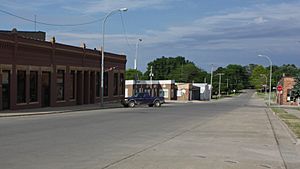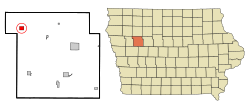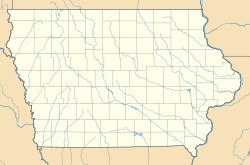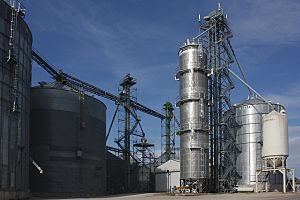Schaller, Iowa facts for kids
Quick facts for kids
Schaller, Iowa
|
|
|---|---|

Eastward view along 2nd St.
|
|

Location of Schaller, Iowa
|
|
| Country | |
| State | |
| County | Sac |
| Township | Eureka |
| Area | |
| • Total | 1.26 sq mi (3.26 km2) |
| • Land | 1.26 sq mi (3.26 km2) |
| • Water | 0.00 sq mi (0.00 km2) |
| Elevation | 1,411 ft (430 m) |
| Population
(2020)
|
|
| • Total | 729 |
| • Density | 579.03/sq mi (223.59/km2) |
| Time zone | UTC-6 (Central (CST)) |
| • Summer (DST) | UTC-5 (CDT) |
| ZIP code |
51053
|
| Area code(s) | 712 |
| FIPS code | 19-71085 |
| GNIS feature ID | 0465956 |
Schaller is a small city in Sac County, Iowa, United States. In 2020, about 729 people lived there. It's a quiet place with a history tied to farming and a surprising past as the "Popcorn Capital of the World."
Contents
History of Schaller
Schaller was officially started in 1882. It was named after Phillip Schaller. The city began a few years earlier, in 1879. It was a stop for a new railroad being built.
The main business in Schaller has always been helping nearby farms. People who settled here came from Germany, England, Canada, New York, and eastern Iowa.
In the middle of the 1900s, Schaller was famous for popcorn. Two big companies, Bango and Jolly Time, packed popcorn here. This made Schaller known as "The Popcorn Capital of the World." Popcorn is still important to the area. However, the companies moved to other places in the 1980s. The railroad stopped running in the 1970s. Today, you can reach Schaller by U.S. Route 20 and Iowa Highway 110. Farmers in the area grow corn and soybeans. They also raise cattle.
Geography of Schaller
Schaller is located at 42°29′50″N 95°17′39″W / 42.49722°N 95.29417°W. This means it's in the northwestern part of Iowa.
The United States Census Bureau says the city covers about 1.26 square miles (3.26 square kilometers). All of this area is land. There are no large lakes or rivers within the city limits.
Population and People
| Historical populations | ||
|---|---|---|
| Year | Pop. | ±% |
| 1890 | 333 | — |
| 1900 | 661 | +98.5% |
| 1910 | 646 | −2.3% |
| 1920 | 731 | +13.2% |
| 1930 | 724 | −1.0% |
| 1940 | 758 | +4.7% |
| 1950 | 841 | +10.9% |
| 1960 | 896 | +6.5% |
| 1970 | 835 | −6.8% |
| 1980 | 832 | −0.4% |
| 1990 | 768 | −7.7% |
| 2000 | 779 | +1.4% |
| 2010 | 772 | −0.9% |
| 2020 | 729 | −5.6% |
| Source: and Iowa Data Center Source: |
||
2020 Population Data
In 2020, there were 729 people living in Schaller. There were 297 households. A household is a group of people living together in one home.
Most people in Schaller are White. About 21% of the population is Hispanic or Latino.
The average age of people in Schaller was 38 years old. About 28% of the people were under 20 years old. This means there are many young people and families in the city.
Education in Schaller
Schaller is part of the Schaller-Crestland Community School District. This school district was created on July 1, 1993. It happened when the Schaller Community School District and the Crestland Community School District joined together.
See also
 In Spanish: Schaller (Iowa) para niños
In Spanish: Schaller (Iowa) para niños




